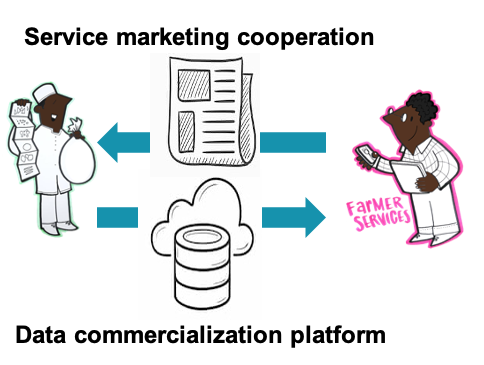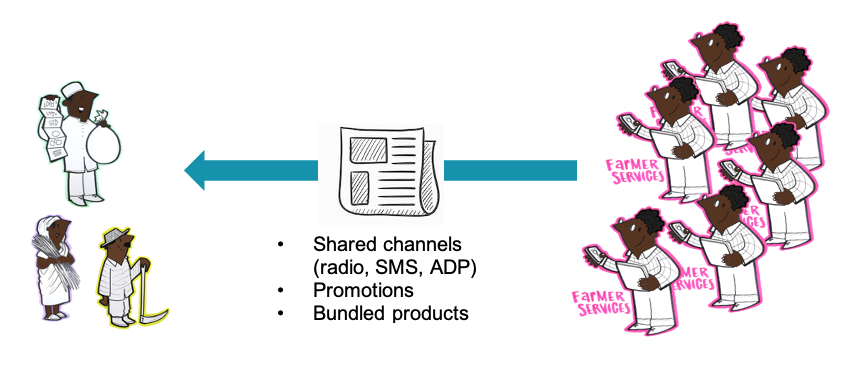Satellite data can enable multiple ag tech services and make them affordable and accessible to small farmers in Africa, including advisory, credit and insurance. Today, services exist, but at a very small scale and with limited relevance. More fine grained data and greater reach is necessary for them to work commercially and have a tangible impact. The ii2030 ag track identified extension workers as the critical interface to achieve this scale. Our discussion focussed on Nigeria, where many agtech startups operate and the conditions for scale up are generally good.
Extension services are an important link to smallholder farmers, providing advisory, but sometimes also inputs and market linkages. In Nigeria, several organizations provide extension services. The public extension agents are today few in number, with only 14.000 agents for the whole country, each catering on average to 10.000 farms. In addition, there are about 8000 private extension workers. The National Agricultural Extension and Research Liaison Services (NAERLS) builds knowledge and supports the regional programs via trainings as well as via a farmer helpline. Sasakawa Africa Association as a private foundation is supporting the education of extension workers in several states. Traders with outgrower schemes such as Olam or ECOM are providing their own support to farmers. Lastly, new actors are joining the field with the model of agripreneurs, providing farmer services as a business. For example, Syngenta Foundation is about to launch an agripreneurship program, including a digital interface.
Since farmers need human support in order to learn about and use agtech services, extension workers are an important “route to market” for agtechs. At the same time, extension workers are collecting critical data from farmers, including farm sizes, crops grown, inputs used, yields and prices achieved. Building an interface to reach out to extension workers and to collect data from them could thus be the critical infrastructure to enable scale up. Extension workers can benefit from engagement with agtechs by being able to offer more services and charge fees (depending on their status and contract). Low pay and revenues or, from an organizational perspective, high cost of extension is a main reason why few extension workers are available today. Additional revenues could thus also scale up the presence of these critical service providers.
How to build this interface? The ii2030 agriculture track participants identified two independent but interlinked solutions.

- Service marketing cooperation can enable agtechs to reach extension workers in a coordinated way. This would make it easier for extension workers as well as farmers to select among the existing services. NAERLS as the public agency supporting extension could help to ensure that only services that have tangible benefits for small farmers get promoted. Fr example, this quality assurance oculd be achieved via and advisory board. Agtech services could then promote their offering to extension agents and farmers via existing communication channels, including trainings, SMS and the farmer helpline. In addition, NAERLS or Sasakawa Africa Association could convene the qualified agtech services in order to enable them to bundle their services, develop joint promotions and improve interoperability. The cooperation could also include research to understand the actual benefits for extension workers and farmers, thus providing evidence to inform continuous improvement.

- A data commercialization platform can make data available to all agtechs, thus sharing and reducing costs of data. The platform can integrate different sources of data, including satellita data and ground data that is collected by extension agents, other ground data available from public sources or non-governmental organizations. Agtechs can also feed in data they generate. Agtechs would thus both be suppliers and customers of the platform and would gain a new revenue stream from the data they supply. In addition to a pure data warehouse, such a platform could also include the providion of generic algorithms to process the data. For example, most agtech services require algorithms to identify the field size or vegetation.

This initiative will contribute to making satellite-enabled agtech services available to smallholder farmers in Nigeria at a broad scale. The expected impact?
- Farmers have easier access to validated agtech services via extension workers.
- Agtech services can bundle products, thus achieving synergies and higher value for farmers.
- Data is available and affordable for agtechs
Farmers will benefit from access to satellite enables agtech services in multiple ways: being able to manage risks better, unlocking their ability to invest and manage their farm as a business, and, ultimately, achieving higher yields and profits.
____________________________
This article was written by Dr. Christina Tewes-Gradl based on the results of the ii2030 ag track. ii2030 is Endeva’s proven approach to create partnerships change systems by leveraging technology and contributing to a more inclusive and future-fit society by 2030. This year’s edition was run in collaboration with #Africa4Future and funded by the Deutsche Gesellschaft für Internationale Zusammenarbeit (GIZ) GmbH on behalf of the German Federal Ministry for Economic Cooperation and Development (BMZ). For more information contact Christina.


